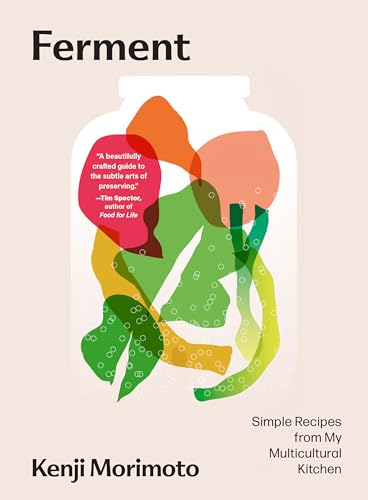Ferment: Simple Recipes from My Multicultural Kitchen by Kenji Morimoto
Fermentation books can be hit or miss—either too simplistic and safe, or so complex they feel like a lab manual written for people who casually keep a koji chamber in their basement. (Noma, I’m glaring at you.) Ferment by Kenji Morimoto manages to strike that rare balance: accessible without dumbing it down, detailed without being condescending, and with enough inspiration to make even a seasoned fermenter reach for a clean jar.
This book focuses primarily on small-batch lactofermentation—my personal sweet spot—but also dips a careful toe into koji, with just enough depth to intrigue without overwhelming. There’s even a section on pickling, which at first felt slightly out of place, but ultimately serves as a smart contrast. Morimoto doesn’t just tell you there’s a difference between pickling and fermentation—he shows it. That’s something a lot of books gloss over, and I respect the clarity.
Now, let’s talk criteria:
Photos:
Look, in a fermentation book, photos matter. Especially for beginners. People need to see the difference between harmless kahm yeast and mold that should send your jar straight to the compost. While Ferment includes a decent number of photos, I’d love to see more images of things going wrong. The whole “when in doubt, throw it out” line just doesn’t cut it for me without visual context. That said, most books fail this test, so I’m not holding it too harshly against this one.
Measurements:
This is where Morimoto wins serious points. He uses weight-based measurements throughout—because let’s be honest, anything else in fermentation is a guessing game you don’t want to play. He also lays out brine calculations and salt percentages in a way that actually makes sense. Beginner-friendly without being patronizing. Clear. Practical. Well done.
Recipe Quality:
The real test: how many recipes do I actually want to make? With Ferment—almost all of them. That doesn’t happen often. A few are too funky for my personal tastes, sure, but there were several that made me stop mid-page and say “I need to make that.” That immediate, gut-level yes is rare, and this book earned it.
Bonus Points:
The final section? Recipes that actually use the ferments you’ve made. Finally. So many fermentation books stop at “congratulations, here’s your jar of preserved magic” and leave you guessing how to use it. Ferment connects the dots and brings it full circle. That alone makes it worth adding to my shelf and to the library.

